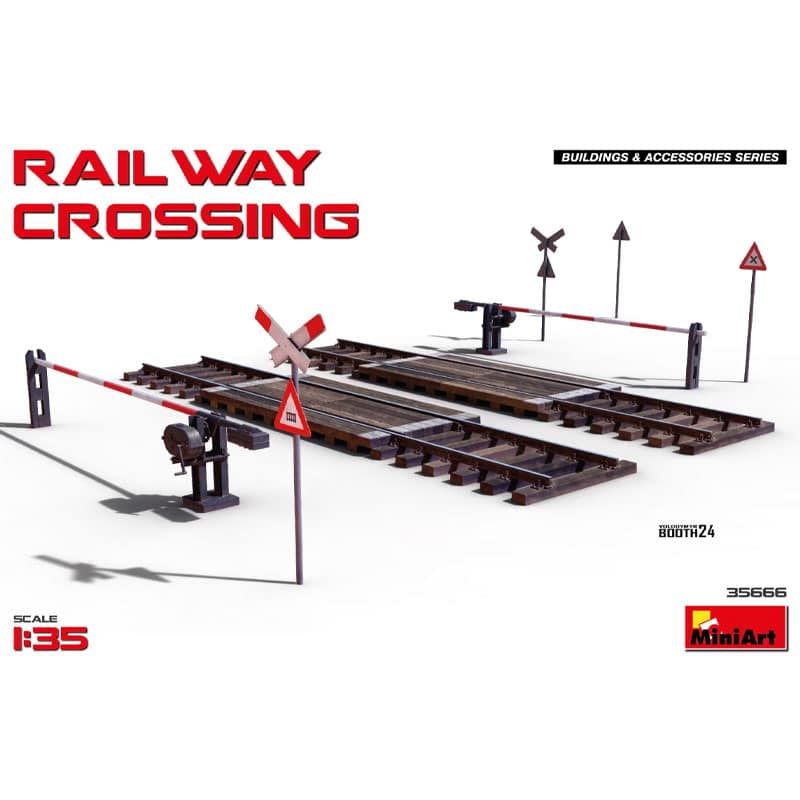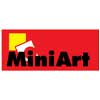MiniArt 35666 1/35 Railway Crossing is a highly detailed diorama accessory kit that allows modellers to create a realistic railway crossing scene, complete with the necessary infrastructure, signage, and surroundings to make it feel authentic to the World War II or post-war period. This set is perfect for anyone looking to enhance their 1/35 scale dioramas with a realistic, dynamic, and historical setting that can be used in a variety of military or civilian-themed scenes.
Scale: The kit is designed for 1/35 scale, which is standard for many military model kits. It offers the perfect level of detail for modelling railway scenes in a historical or military context, and it will fit seamlessly into other dioramas that feature 1/35 vehicles, figures, and buildings.
Complete Railway Crossing Setup:
The kit includes all the necessary components to create a detailed railway crossing. This includes crossing gates, signage, road surfaces, and the rails themselves. These components will allow you to create a highly realistic scene at a train crossing, making it an excellent addition to any diorama that involves train transport or railroad infrastructure during WWII or later.
Crossing gates are moulded in great detail, often including the crossbars and mechanisms that allow them to open and close, offering a more lifelike appearance.
The railway tracks are also finely crafted, and they can be painted and weathered for a more realistic look, either for an operational railway or one that has seen wear and tear over the years.
Historical Context:
This kit can be used in WWII dioramas to represent areas where rail transport was heavily utilised by military forces. Railway crossings were essential to the movement of troops, supplies, and ammunition across vast distances.
In Europe during WWII, railway infrastructure played a significant role in the German logistics system as well as the movement of Allied forces after the D-Day landings. A crossing scene like this could be used in a diorama depicting the German retreat, occupation, or a post-battle scenario where trains are involved in supply or evacuation operations.
Diorama Potential:
The Railway Crossing kit can fit seamlessly into a variety of diorama settings, such as:
German military trains crossing a rural crossing during the Eastern Front or Western Europe campaigns of WWII.
Allied logistics as American or British vehicles pass through a railway crossing while advancing through France or Germany.
A civilian or post-war scene where trains are still in use, or the crossing is part of a reconstruction effort after the war.
The set is especially useful in any diorama featuring train movements, logistics, or transport-related military operations.
Painting and Weathering:
The railway crossing can be painted in a variety of ways to reflect the environment of the diorama. For example:
In WWII Europe, the tracks and the crossing can be painted to reflect the battle-scarred, weathered, and dilapidated nature of infrastructure during wartime.
For post-war scenes, the tracks can be depicted as repaired or restored, with fresh paint on the signage and well-maintained barriers.
Weathering techniques such as dirt accumulation, rust on rails, dust on the road, and faded paint on the barriers can be used to give the scene a lived-in look. Chipping, mud, and grime are especially effective if you’re depicting a battlefield or rural setting.
Diorama Ideas:
WWII Train Transport: Create a dynamic scene where military vehicles or soldiers are crossing a railway junction while a train carrying supplies or troops is visible in the background. This could be a German or Allied train depending on your diorama’s focus.
Post-War Reconstruction: A post-WWII scene could depict a train crossing that has been rebuilt as part of reconstruction efforts, with civilian traffic passing by. This could also feature the transition from military to civilian infrastructure after the war.
Urban or Rural Railway Crossing: A more civilian-focused diorama could involve a crossing in a small town or village, with local people or vehicles passing by as the train slowly crosses. This could show the integration of the railway system in daily life.



